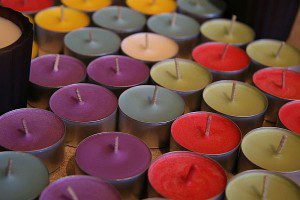Guest Writer for Wake Up World
Candles are great for encouraging relaxation and creating a calm, serene environment. A candle’s aroma and soft, warm glow sets a nice tone for romance, sophistication, and tranquility. Most candles today feature a variety of aromas. While refreshing they may be, the chemicals used to produce a candle’s fragrance can be toxic, polluting the air we breathe. Fortunately, there are safe options, and it’s just a matter of being conscious during your purchasing decisions.
The Health Dangers of Candles
Let’s take a quick look at the components of many candles, and how each component may be contributing to a toxic environment.
[pro_ad_display_adzone id=”110028″]
The Health Dangers of Candle Wicks
One of the main concerns over candles, besides the scents, is the wick. Different wicks are used for different purposes and they can be divided into two main categories: cored and non-cored wicks. Non-cored wicks are usually made of a braided or twisted cotton and considered the safest to burn.
Cored wicks are usually made of cotton around a paper or metal core. Zinc, tin, and lead are standard compounds used in its composition. Burning candles with lead-cored wicks is now known to cause lead poisoning, and there are similar concerns about zinc-cored wicks. In 1974, the National Candle Association of the U.S. voluntarily stopped using lead-cored wicks because of risks with airborne lead.[1] Unfortunately, many countries outside of North America still produce candles using dangerous wicks.
In 2000, the Public Citizen’s Health Research Group published a study in the Journal of the American Medical Association that indicated candles with wicks containing lead were available at 12 different stores in the Washington-Baltimore area.[2] Testing showed that the candle containing the least lead would, during three hours of burning time, produce enough air lead concentration so that a normally active six-year old would exceed the recommended daily lead limit for children in 45 minutes. The authors concluded that there is no reliable method to distinguish lead-containing wicks from other metal-cored wicks.
The Health Dangers of Candle Wax
The type of wax the candle is made of and and how the candle is burned significantly affects air quality. A candle burned in a draft with a smokey, guttering flame will be emitting particulate matter in every direction. If you prefer a candle that has a metal-cored wick, ask the manufacturer what metal is in the wick. If they can’t or won’t tell you, for safety’s sake, choose another candle.
The Health Dangers of Artificial Fragrances
Beeswax and bayberry wax both contain natural scents, beeswax offering the sweet smell of honey and bayberry a spicy, fresh aroma. Scents added to wax vary in their source and composition. Originally, perfumes came from animal and vegetable sources. In the late 1800s, the first synthetic fragrances were produced and were quickly adopted as a cheaper source of aromas. Many people today are sensitive to artificial scents from perfume, candles, and even air fresheners.
Fragrance oils are specially made for particular uses, such as scenting candles, soaps, cosmetics, and potpourris. They are usually synthetic. Exact formulas for fragrances fall under the trade secrets act in the U.S., but manufacturers of the oils will normally be able to produce a Materials Safety Data Sheet which will cover the physical characteristics of the oil, physical or health hazards, and first aid treatment in case of an accident. Candle scents contain stabilizers and fixatives which allow the oils to mix with wax and give off an aroma when heated.
Essential oils are naturally-occurring oils that are extracted mainly from botanical sources. They are usually more expensive than synthetic fragrances, and may not blend well with candle wax. Natural essential oils are more volatile than synthetics and most of them are difficult to use in candles unless they have added stabilizers or fixatives.
The Health Dangers of Other Additives in Candles
Stearic acid was once the only additive available for paraffin candles and is derived from either animal fat or palm oil. It is now often replaced with Vybar, a polymer which raises the melting point of paraffin, allows scents and colors to blend evenly in the wax, and gives the paraffin some of the qualities of more expensive waxes, allowing candle makers to charge more for a cheap candle.
Microcrystallines are a group of substances derived from petroleum that are added to candles to change the texture of the wax, add gloss, increase opacity, etc. Polyethylenes are produced from natural gas. They add gloss, luster, or clear crystals to wax.
Are Candles Safe? The Bottom Line
When candles are lit, they emit these chemicals into the air, the air we breathe. Our bodies take the burden of this indoor air pollution with unknown toxic effects. The American Lung Association even warns people from burning scented or slow-burning candles that contain artificial ingredients. In addition, they suggest burning beeswax candles instead with metal in the wick, or candles that are greasy to the touch.
Choosing Safe Candles
Buy candles from trusted countries. Imported candles often come from countries where they employ chemicals no longer used in North America because of health concerns. Find out what the wick is made of. If your vendor can’t tell you, don’t buy it. Cotton or hemp wicks are considered to be the safest. Choose candles made from beeswax or soy wax. Avoid paraffin.
Be aware that many candle manufacturers make claims for their candles or waxes that can’t be substantiated or are untrue. No candle is “soot-free” because combustion causes soot; however, beeswax and soy wax don’t produce sticky, black, petroleum-based soot.
Do you have a safe candle recommendation? Leave a comment below and share it with us.
– Dr. Edward F. Group III, DC, NP, DACBN, DCBCN, DABFM
Article references:
- National Candle Association. FAQs. National Candle Association.
- Public Citizen. Millions of Dangerous Candles Sold Throughout U.S. Public Citizen.
Previous articles by Dr. Group:
- How Turmeric Keeps You Looking Young
- 7 Toxins Harming Your Brain Right Now
- Top 5 Foods for the Pineal Gland
- 6 Things You Must Know About Colloidal Silver
- The Importance of a Kidney Cleansing Diet
- The 9 Best Herbs for Lung Cleansing and Respiratory Support
- 7 Best Foods to Support Kidney Function
- Lung Cleansing With Peppermint Oil
- Seven Facts You May Not Know About Coconut Oil
- 10 Best Herbs for Boosting Female Sex Drive
About the author:
 Dr. Edward F. Group III (DC, ND, DACBN, DCBCN, DABFM) founded Global Healing Center in 1998 and is currently the Chief Executive Officer. Heading up the research and development team, Dr. Group assumes a hands-on approach in producing new and advanced degenerative disease products and information.
Dr. Edward F. Group III (DC, ND, DACBN, DCBCN, DABFM) founded Global Healing Center in 1998 and is currently the Chief Executive Officer. Heading up the research and development team, Dr. Group assumes a hands-on approach in producing new and advanced degenerative disease products and information.
Dr. Group has studied natural healing methods for over 20 years and now teaches individuals and practitioners all around the world. He no longer sees patients but solely concentrates on spreading the word of health and wellness to the global community. Under his leadership, Global Healing Center, Inc. has earned recognition as one of the largest alternative, natural and organic health resources on the internet.
For more information, please visit Global Healing Center.
[pro_ad_display_adzone id=”110027″]







